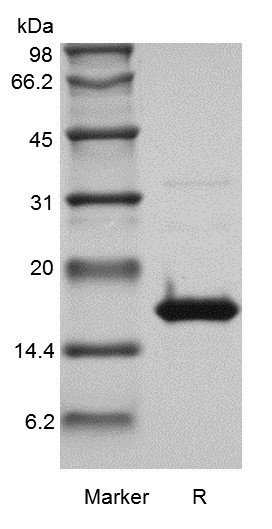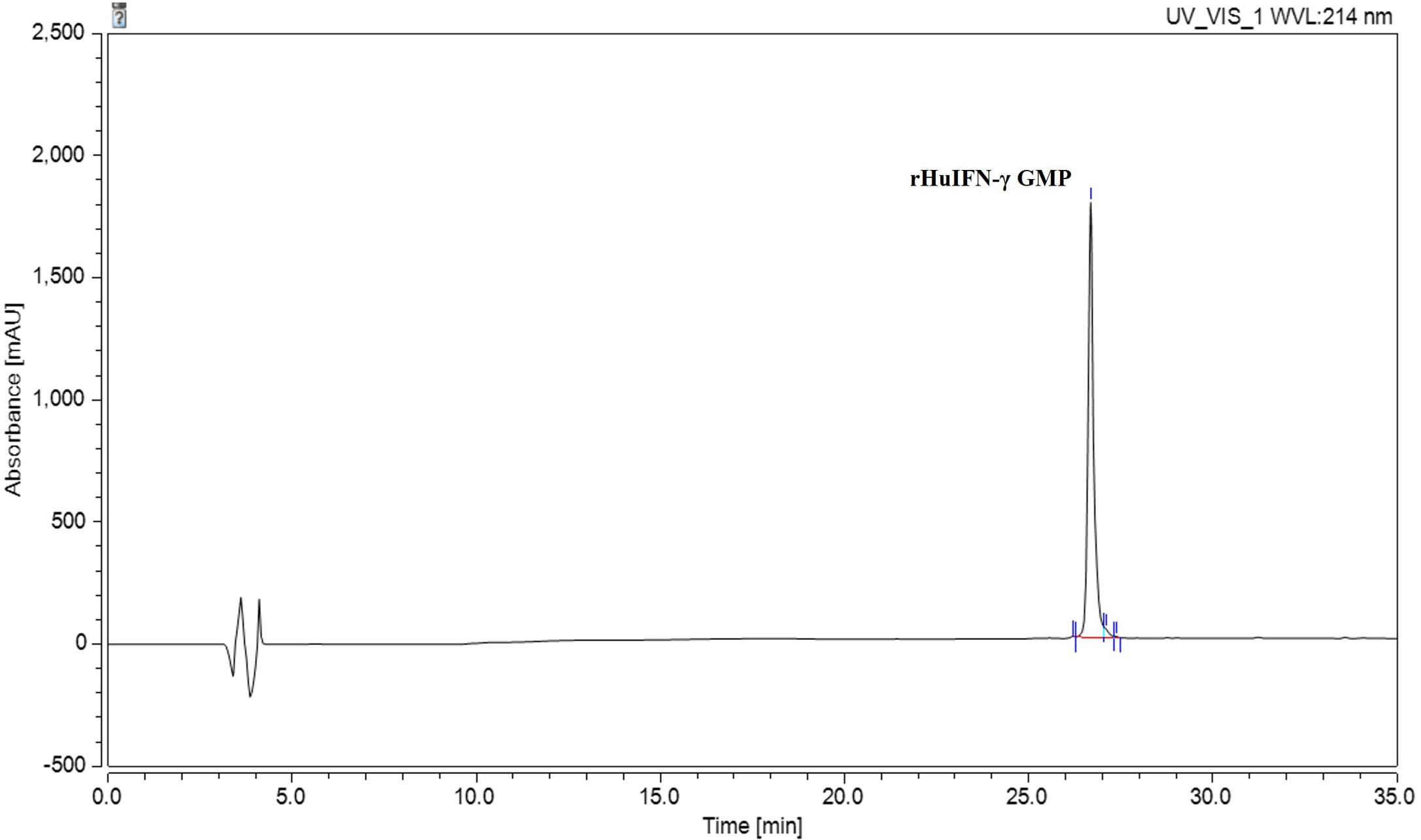- Source
- Escherichia coli
- Molecular Weight
- Approximately 16.9 kDa, a single non-glycosylated polypeptide chain containing 144 amino acids.
- Sequence
- MQDPYVKEAE NLKKYFNAGH SDVADNGTLF LGILKNWKEE SDRKIMQSQI VSFYFKLFKN FKDDQSIQKS VETIKEDMNV KFFNSNKKKR DDFEKLTNYS VTDLNVQRKA IHELIQVMAE LSPAAKTGKR KRSQMLFRGR RASQ
- Purity
- > 98% by SDS-PAGE and HPLC analyses.
- Biological Activity
- Assay #1: Fully biologically active when compared to standard. The ED50 as measured in anti-viral assays using human HeLa cells infected with encephalomyocarditis (EMC) virus is 0.15-0.80 ng/mL. The specific activity of recombinant human IFN-γ is > 1.0 × 107 IU/mg, which is calibrated against rHuIFN-γ WHO International Standard (NIBSC code: 87/586).Assay #2: The ED50 as determined by a cytotoxicity assay using human MCF-7 cells is less than 14 ng/mL.
- Physical Appearance
- Sterile filtered white lyophilized (freeze-dried) powder.
- Formulation
- Lyophilized from a 0.2 µm filtered concentrated solution in PBS, 3% Trehalose, pH 5.0.
- Endotoxin
- Less than 0.01 EU/µg of rHuIFN-γ GMP as determined by LAL method.
- Sterility
- Negative.
- Mycoplasma
- Negative.
- Host Cell Protein
- Less than 0.05% when tested by ELISA.
- Host Cell DNA
- Less than 20 ng/mg when tested by qPCR.
- Reconstitution
- Prior to opening, it is recommended to centrifuge the vial briefly to bring the contents down the bottom. Reconstitute in sterile distilled water or aqueous buffer containing 0.1% BSA to a concentration of 0.1-1.0 mg/mL. If animal-origin-free condition is expected in your product, then sterile distilled water is recommended. Stock solutions should be apportioned into working aliquots and stored at ≤ -20 °C. Further dilutions should be made in appropriate buffered solutions.
- Shipping
- The product is shipped with polar packs. Upon receipt, store it immediately at the temperature recommended below.
- Stability & Storage
- Use a manual defrost freezer and avoid repeated freeze-thaw cycles.
- A minimum of 12 months from date of receipt, when stored at ≤ -20 °C as supplied.
- 1 month, 2 to 8 °C under sterile conditions after reconstitution.
- 3 months, -20 to -70 °C under sterile conditions after reconstitution.
- Refer to lot-specific CoA for the Expiry Date.
- Usage
- This material is offered by Shanghai PrimeGene Bio-Tech for research, laboratory, or further evaluation purposes. NOT FOR HUMAN USE.
- Quality Statement
- The manufacturing and testing of these products comply with ICH Q7 guidelines.
- Background
- Interferon-gamma (IFN-γ), also known as Type II interferon or immune interferon, is a cytokine produced primarily by T-lymphocytes and natural killer cells. The protein shares no significant homology with IFN-β or the various IFN-α family proteins. Mature IFN-γ exists as noncovalently-linked homodimers. Human IFN-γ is highly species specific and is biologically active only in human and primate cells. IFN-γ was originally characterized based on its antiviral activities. The protein also exerts antiproliferative, immunoregulatory and proinflammatory activities and is thus important in host defense mechanisms. IFN-γ induces the production of cytokines, upregulates the expression of class I and II MHC antigens, Fc receptor and leukocyte adhesion molecules. It modulates macrophage effector functions, influences isotype switching and potentiates the secretion of immunoglobulins by B cells. IFN-γ also augments TH1 cell expansion and may be required for TH1 cell differentiation.









 COA Application
COA Application


